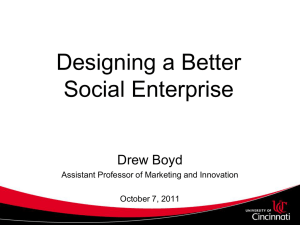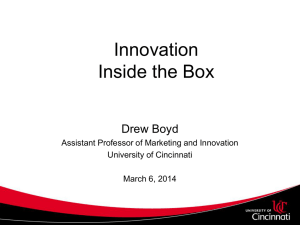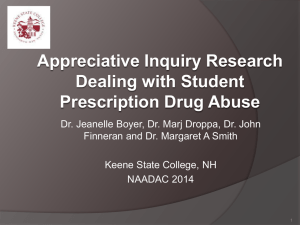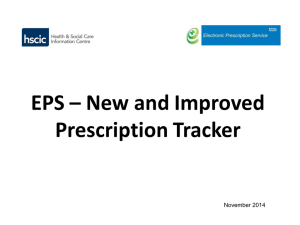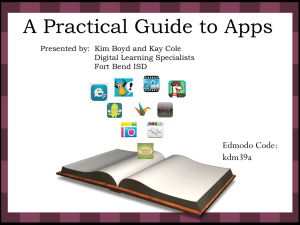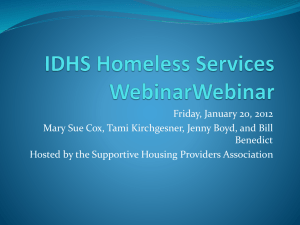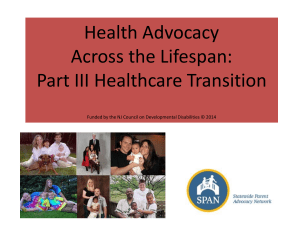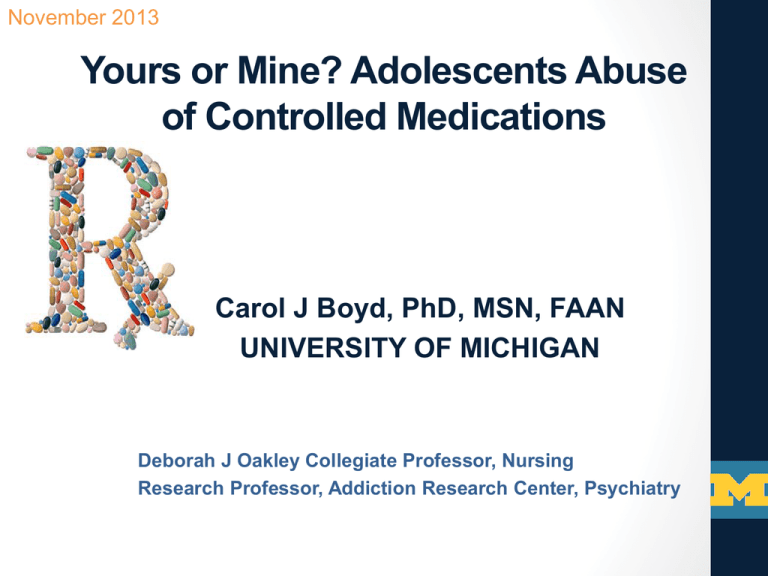
November 2013
Yours or Mine? Adolescents Abuse
of Controlled Medications
Carol J Boyd, PhD, MSN, FAAN
UNIVERSITY OF MICHIGAN
Deborah J Oakley Collegiate Professor, Nursing
Research Professor, Addiction Research Center, Psychiatry
Funding
• National Institute on Drug Abuse
DA018272 (PI: Boyd), DA024678 (PI: Boyd)
DA018239 ,DA019492, DA 031160 (PI: McCabe)
T32 DA007267 (Co-Directors: Gnegy & Boyd)
• University of Michigan
• Office of the Vice President for Research
• Institute for Research on Women & Gender
• UM Substance Abuse Research Center
• UM Addiction Research Center
Team Members (alphabetical order)
Researchers:
James Cranford, Sean McCabe, Quyen Epstein-Ngo,
Elizabeth Meier, Paula Ross-Durow, Christian Teter,
Phil Veliz and Amy Young
Staff:
Kitty Lunquist, Janie Slayden and Kelly Simion
Schools:
We thank the staff, parents, and students of the schools
involved in this study
Conflict of Interest
No Conflict of Interest to Report
Objectives
• Characterize the prevalence and trends in adolescents’ medical
misuse, nonmedical use & diversion of scheduled medications (e.g.
opioid analgesics, stimulants, sedative/anxiolytics).
• Identify the limitations of the current epidemiological studies relative to
their measures (e.g. NSDUH, NESARC, MTF).
• Differentiate among the sub-types of medical & nonmedical users.
• Provide an example of a provider prevention strategy.
BACKGROUND
National Data
• National Survey on Drug Use and Health (SAMHSA)
• Nonmedical use of prescription medications
•
•
•
•
U.S. population (lifetime = 20.4% and past year = 6.3%)
12-17 years old (lifetime = 10.6% and past year = 7.4%)
18-25 years old (lifetime = 28.7% and past year = 14.3%)
26+ years old (lifetime = 20.1% and past year = 4.8%)
• Two classes that are of concern because of prevalence rates
are: opioid analgesics and stimulant medications.
• These drug classes will be my primary focus today
• Adolescents often engage in poly-pill use.
Main Reason for Using a Prescription Drug
(without a prescription)
To Help Me Relax
18%
To Have Fun
16%
B ecause B eing High Feels G ood
14%
To Help Me Forget My Troubles
13%
To Deal with Pressures and Stress of School
11%
My Friends Are Using
11%
To Help Deal with Problems at Home
8%
To Feel B etter About Myself
To Look Cool
8%
6%
It's a Habit, I Can't Stop
0%
4%
10%
20%
30%
40%
50%
N=3884 US High School Reporting Lifetime Use of Rx drugs w/o a prescription the last time
you used it.
*Adapted by CESAR from The Partnership for a Drug-Free America and the MetLife Foundation, The Partnership Attitude Tracking
Study (PATS): Teens and Parents, 2013. Available online at http://www.drugfree.org/newsroom/research-publication/full-report-and-keyfindings-the-2012-partnership-attitude-tracking-study-sponsored-by-metlife-foundation .
Percentage of U.S. Youths Reporting How Long It Would
Take Them to Get to Drugs in 2012
100%
80%
50%
44%
60%
34%
19.0%
31%
Within a Day
or Less
18.0%
Within a Week
or Longer
14.0%
40%
15.0%
36%
40%
45%
Would B e
Unable to G et
Don't Know/
No Response
20%
31%
0%
4%
6%
7%
6%
Alcohol
Cigarettes
Prescription Drugs
Marijuana
N=1,003 youth ages 12 to 17 years
NOTES: Data are from a random sample of households in the 48 continental states who had a person ages 12 to 17 living in
the household. Computer-assisted telephone interviews were conducted between April 18 and May 17, 2012 with
1,003 youths who were randomly selected from the nationally representative household sample frame. The margin
of error is +/-3.1 percent at a 95 percent confidence level (unadjusted for weighting).
SOURCE: Adapted by CESAR from The National Center on Addiction and Substance Abuse at Columbia University (CASA),
National Survey of American Attitudes on Substance Abuse XVII: Teens, 2012. Available online at
http://www.casacolumbia.org/upload/2012/20120822teensurvey.pdf.
Source of Misused Prescription Opioids
Grade 12 Students Using in Past Year
Johnston LD, et al. Monitoring the Future National Results on Adolescent Drug Use. Overview of Key Findings, 2009. NIH Publication No.
[to be assigned]. Bethesda, MD: National Institute on Drug Abuse. 2010.
Coming to Terms…
What will we call it?
The terms prescription drug abuse, nonmedical use of
prescription medication, extra medical use and medical
misuse are used in the literature but there is little
consistency in how these terms are defined.
Usually two distinctive groups are included: those people
misusing or abusing their own prescription medications or
alternatively, those people misusing or abusing someone
else’s prescription medicine.
Is it Mine or Yours?
Usually two distinctive groups included but these are often
collapsed by researchers or not clearly defined in the
measures:
•
Those people misusing or abusing their own
scheduled medications and/or
•
Those people misusing or abusing someone else’s
scheduled medicine.
National Studies
• The National Survey on Drug Use and Health (NSDUH), Monitoring
the Future (MTF) and, National Epidemiologic Survey on Alcohol and
Related Conditions (NESARC) are the three largest national studies
focused on substance abuse; they rely on different survey questions
to assess what people refer to as prescription drug abuse.
• MTF stipulates it was taken without a doctor’s order.
• NSDUH stipulates that the medication was not prescribed or only taken
for the experience or feeling it caused.
• NESARC adds that it was taken in greater amounts, more often or longer
than prescribed.
• The MTF, NSDUH and NESARC surveys fail to distinguish between
people who self-treat with their own medications versus those who
use to get high or create an altered state.
Subtypes
NONMEDICAL USE
MEDICAL MISUSE
Person does not possess
legal prescription
Person does possess legal
prescription
Sensation-seeking:
get high, experiment, or create
altered state (w/ someone
else’s meds)
Sensation-seeking:
get high, experiment, or
create altered state (w/ own
meds)
Self-treating:
self-treat symptoms of actual or
perceived health condition (w/
someone else’s meds)
Self-treating:
self-treat symptoms of actual
or perceived health condition
(w/ own meds)
Boyd, C.J., & McCabe, S.E. (2008). Coming to terms with the nonmedical use of prescription medications. Substance Abuse Treatment,
Prevention and Policy, 3(1), 22.
Key Definitions
• Medical misuse of controlled medications (prescription drugs):
• use of scheduled medications (II-V) by the person (and for the
purpose) intended by the prescribing clinician; however, the
medication is:
• NOT used in the prescribed dose and/or not taken within a prescribed
time interval.
• Nonmedical use of controlled medications (prescription drugs):
• use of scheduled medications (II-V) by people other than what the
prescribing clinician intended.
• Diversion of controlled medications (prescription drugs):
• exchange of scheduled medications (II-V) that leads to the use of
these:
• by people other than whom the prescribing clinician intended or
• under conditions associated with “doctor shopping” or
misrepresentation
• by theft or drug dealing.
DA018272 (PI: Boyd), DA024678 (PI: Boyd)
DA018239 ,DA019492, DA 031160 (PI: McCabe)
REVIEW OF 6 STUDIES
Study Design: Mixed Method
• 3 public high schools and 2 public middle schools
located in two communities in southeastern Michigan.
• The Secondary Student Life Survey (SSLS) was administered
to all the students (7th – 12th grade) during the 2009-10, 201011, 2011-12 school years.
• The SSLS is a web-based survey administered to students on
during school hours.
• Longitudinal sample created from cross-section.
• Panel cohort of 7th and 8th graders and their parents.
• The SSLS takes approximately 25-35 minute.s
• Includes standardized and/or valid measures (e.g. MTF,
CRAFFT and DAST 10).
• Four waves of data, three will be included in these studies.
Salburg Schools*
• Salberg School District (1 high school and 1 middle school)
• Stable middle-class community (Census)
• Median household income of $66,304 ($48,669 for all of Michigan).
• 3.1% unemployment rate (7.7% for all of Michigan).
• 3.5% of families living below the poverty line (11.1% for all of Michigan).
• School Characteristics (CCD)
• The two schools from Salberg have 8% of the student body eligible for free
or reduced price lunches.
• 90% of the students who attended the two schools from Salberg are
classified as White.
• Both schools are considered low poverty schools (i.e. have below 25% of
students eligible for free or reduced price lunches).
*pseudonym
Fernridge Schools*
• Fernridge School District (1 high schools; 1 middle school; 1 grant supported
charter school for Detroit students).
• Working-class community (Census)
• Median household income of $50,174 ($48,669 for all of Michigan)
• 8.1% unemployment rate (7.7% for all of Michigan)
• 8.5% of families living below the poverty line (11.1% for all of Michigan)
• School Characteristics (CCD)
• The three schools from Fernridge have roughly 67.5% of the student body eligible
for free or reduced price lunches.
• Approximately 70% of the students who attended the three schools from Fernberg
are classified as Black.
• All three schools are classified as mid-high poverty schools (i.e. have between 51%
and 75% of the student body eligible for free or reduced price lunches).
*pseudonym
Sample Sizes and Response Rates
Sample Characteristics Across the Three
Waves
• Sex
• 49.8% male
• 50.2% female
• Grade
• 14% 7th grade (12 years old)
• 16% 8th grade (13 years old)
• 19% 9th grade (14 years old)
• 18% 10th grade (15 years old)
• 17% 11th grade (16 years old)
• 16% 12th grade (17 years old)
• Race
– 64% White
– 30% Black
– 2% Hispanic
– 3% Asian
– 1% Other Race
Procedure
• This study is part of a larger, mixed-method longitudinal study
that has a Certificate of Confidentiality from NIH.
• We administer annual web-based surveys for cross-sectional data
• We follow a panel of 1500 who have completed three surveys;
• We interview a 7th-8th grade cohort (N=500) twice a year, and survey
their parents once/year
• These data reported here were collected over three, five
month periods between December 2009 and April 2012.
• Five public schools in southeastern Michigan were involved (2
middle and 3 high school).
• The Secondary Student Life Survey (SSLS) was administered via
the web during one class period.
• Computers were hooded
NIH GRANT R01 DA024678
Measures: Student Life Survey
•
Demographic information (e.g., sex, race)
•
Health Behavior (e.g. nutrition)
•
School involvement (e.g., clubs, athletics)
•
Medical use (e.g., Stimulant medication (Ritalin®, Dexedrine®, Adderall®, Concerta®,
etc…for ADHD)
•
•
Key characteristics (e.g., diversion, use too much, get high)
Nonmedical use (e.g., Pain medication (Vicodin®, OxyContin®, Percocet®, etc…not
prescribed to you)
•
Key characteristics (e.g., motive, co-ingestion, administration route)
•
Drug use related problems (e.g., DAST-10, CAGE)
•
Diversion (e.g. selling, loaning, giving away drugs)
•
Problem behaviors (e.g. gambling, sexual activity, etc.)
Controlled Medications
1) Sleeping medication (e.g., Ambien®, Halcion®,
Restoril®, temazepam, triazolam)
2) Sedative/anxiety medication (e.g., Ativan®, Xanax®,
Valium®, Klonopin®, diazepam, lorazepam)
3) Stimulant medication (e.g., Ritalin®, Dexedrine®,
Adderall®, Concerta®, methlyphenidate)
4) Pain medication (i.e., opioids such as Vicodin®,
OxyContin®, Tylenol 3 with codeine®, Percocet®,
Darvocet®, morphine, hydrocodone, oxycodone)
Measure
“The following questions are about the use of
prescribed medicines. We are not interested in your
use of over-the-counter medicines that can be
bought in drug or grocery stores without a
prescription, such as aspirin, Sominex®, Benadryl®,
Tylenol PM®, cough medicine, etc. “
NIH GRANT R01 DA024678
Measure: Medical Use
On how many occasions in your lifetime (past
12 months) has a doctor, dentist, or nurse
prescribed the following types of medicine for
you?
(a) Prescribed sleeping medication (e.g., Ambien®, Lunesta®, Restoril®, temazepam,
triazolam);
(b) Prescribed anti-anxiety medication (e.g., Ativan®, Xanax®, Valium®, Klonopin®,
diazepam, lorazepam);
(c) Prescribed stimulant medication (e.g., Ritalin®, Dexedrine®, Adderall®,
Concerta®, methylphenidate);
(d) Prescribed pain medication (e.g., Vicodin®, OxyContin®, Tylenol 3® with codeine,
Percocet®, Darvocet®, morphine, hydrocodone, oxycodone).
NIH GRANT R01 DA024678
Measure: Nonmedical Use
On how many occasions in your lifetime (past 12
months) have you used the following types of
medicine, not prescribed to you?
(a) Prescribed sleeping medication (e.g., Ambien®, Lunesta®, Restoril®,
temazepam, triazolam);
(b) Prescribed anti-anxiety medication (e.g., Ativan®, Xanax®, Valium®,
Klonopin®, diazepam, lorazepam);
(c) Prescribed stimulant medication (e.g., Ritalin®, Dexedrine®, Adderall®,
Concerta®, methylphenidate);
(d) Prescribed pain medication (e.g., Vicodin®, OxyContin®, Tylenol 3® with
codeine, Percocet®, Darvocet®, morphine, hydrocodone, oxycodone).
NIH GRANT R01 DA024678
Measures: Diversion (4 Questions)
“On how many occasions (if any) in your lifetime
have you ever…1) …sold any of your prescription
medication to someone?” 2) “…given or loaned
your prescription medication to someone?” 3)
“…traded your prescription medication for
something else (e.g., other medications, other
drugs, clothes, etc.)? 4) “…been approached to
sell, trade, or give away your prescription
medication?”
NIH GRANT R01 DA024678
These questions were asked for each of the four drug classes.
Scoring
For purpose of the analyses, a binary variable (yes/no)
was created for lifetime or 12 month:
(a) Prescribed use of each class of
controlled medication
(b) Prescribed use of at least one of the four
classes of controlled medications.
(c) Diversion of each class of controlled
medication
NIH GRANT R01 DA024678
For some of the analyses…
• Past 12-months nonmedical use of prescription
medications (NUPM): A binary variable was created from items
asking about frequency of nonmedical use of sleeping, anti-anxiety,
stimulant, pain, addiction medication, asthma inhaler and
antidepressants.
• Past 12-months excessive medical use of
prescription medications (EXPM) A binary variable
was created indicating if excessive medical use occurred.
• Alcohol, Tobacco, Marijuana, and Illicit Drug
Use were measured with items from the Monitoring the Future study
(Johnston et al., 2012). Participants were asked about their frequency
during the past 12 months and binary variables were created.
Generally…
• Girls are more likely to have a prescription for an opioid;
• Girls are more likely to engage in prescription drug abuse to
self-treat;
• Girls are more likely to share medications so as to “help.”
• Boys are more likely to have a prescription for a stimulants;
• Boys are more likely to engage in prescription drug abuse for
purposes other than self-treatment;
• Boys are more likely to share medication by selling.
• Relatively few racial differences, although African American
youth are at greater odds of giving away, and not selling.
Study 1
• What is the extent of medical
misuse of controlled medications
by adolescents?
• How is misuse associated with
other types of substance use
behaviors?
McCabe SE, West BT, Cranford JA, Ross-Durow, P., Young, A.,
Teter, C., Boyd, CJ. et al. Medical Misuse of Controlled
Medications Among Adolescents. Arch Pediatr Adolesc Med.
2011;165:729-735
DA018272 (PI: Boyd), DA024678 (PI: Boyd)
Medical Misuse of Controlled Medications:
Adolescents
n = 2,957
16% had a Controlled Medication Prescribed in the Past Year
Substance Use, Medical Use and Medical
Misuse of Controlled Medications
p<.001 for
all
comparisons
Study 2
• What is the prevalence of
diverting controlled medications?
• Is diversion associated with other
types of substance abuse
behaviors?
McCabe SE, West BT, Teter CJ, Ross-Durow, P, Young, A. & Boyd, CJ. Characteristics
associated with the diversion of controlled medications controlled among adolescents.
Drug Alcohol Depend. 2011; 2118:452-458.
DA018272 (PI: Boyd), DA024678 (PI: Boyd)
Prevalence of Diversion by Drug Class
33% reported having a prescription during their lifetime (n = 848)
Substance Use as a Function of Diversion
n = 2,625
p<.05 for all
comparisons
Study 3
• What are the
characteristics of
nonmedical users
(opioids)? Are they
other drug users?
• Who gives
nonmedical users
their opioid
analgesics?
DA018272 (PI: Boyd), DA024678 (PI: Boyd)
Motives for Nonmedical Use of Prescription
Opioids
Sources for Nonmedical Use of
Prescription Opioids and CRAFFT scores
Top Five Diversion Sources
Study 4
Does misuse of
prescription opioids
lead to future misuse
and other substance
abuse?
McCabe SE, West BT, Boyd CJ. Medical use,
medical misuse, and nonmedical use of
prescription opioids: Results from a longitudinal
study. Pain. 2013;154:708-713.
DA018272 (PI: Boyd), DA024678 (PI: Boyd)
Gender Differences in Past Year Opioid Use
Medical Use, Medical Misuse, and
Nonmedical Use of Prescription Opioids
Over Time
Substance Abuse at Time 2 as a Function of Medical
Use, Misuse and Nonmedical Use of Prescription
Opioids in Year 1
***p<.001
All comparisons are
made to No Medical or
Nonmedical Use
Study 5
Are their subtypes of
nonmedical users of
opioid medications?
Young A, McCabe SE, Cranford, Ross-Durow, P.,
Boyd, CJ. Nonmedical use of prescription
opioids among adolescents: Subtypes based on
Motivation for use. Journal of Addictive
Diseases. 2012;31:332-341.
DA018272 (PI: Boyd), DA024678 (PI: Boyd)
Subtypes Based on Problem Behaviors
variable
Function 1a
Function 2b
Rule Breaking Behavior
.80*
-.09
CRAFFT score
.70*
-.05
Illicit Drug Use
.58*
-.14
Aggressive Behavior (YSR)
.54*
.07
Physical Symptoms
.50*
.42
Marijuana Use
.43*
-.15
Binge Drinking
.39*
.03
Withdrawn/Depressed (YSR)
.38*
.30
Social Victimization
.36*
-.06
Physical Victimization
.20*
.06
Somatic Complaints (YSR)
.34
.78*
Anxious/Depressed (YSR)
.42
.49*
Sexual Victimization
.17
.25*
n = 2,597
Early Sexual Activity
.23
-.26
Correlations between discriminating variables and discriminant functions (i.e. function 1a and 2b)
Plotting the Group Centroids of Different
Types of Users on Function 1a and 2b
Nonusers (n = 2158)
Medical Users (n = 323)
Nonmedical Self-Treaters (n = 70)
Nonmedical Sensation Seekers (n = 66)
In a study related to Study 6
• We found that:
Behavioral Never
Disorders Used
Medical
Use
Non-med
Pain
Nonmedical
Non-pain
Affective
5.2%
9.9%
8.7%
36.6%
Anxiety
3.0%
3.9%
3.3%
14.6%
ADHD
2.5%
2.6%
2.2%
19.5%
Conduct
3.4%
4.7%
8.7%
46.3%
Somatic
4.3%
9.3%
41.2%
31.7%
Non-medical sensations seekers were significantly different from other
groups at p<.01 based on multi-nomial logistic regression w/ this gp as
reference category.
Study 6
The objective of this
descriptive study was to
determine adolescents’
access to their own
medications at home,
specifically prescription pain,
stimulant, anti-anxiety, and
sedative medications.
Ross-Durow, P. L., McCabe, S. E., & Boyd, C. J.
(2013). Adolescents’ access to their own
prescription medications in the home. Journal
of Adolescent Health, 53, 260-264.
DA018272 (PI: Boyd), DA024678 (PI: Boyd)
Sample (Cohort Study)
Boys n= 246 (49%)
Girls n=255 (51%)
White: 194 (38.7%)
White: 171 (34.1%)
Black: 52 (10.4%)
Black: 56 (11.2%)
Other: 9 (1.8%)
Other: 19 (3.8%)
Mean age: 14.1 years
Mean age: 14 years
Controlled medications (opioids, anxiolytic,
stimulants & sedatives
Overall sample
Boys
Girls
57/240 (24.8%)
33/57 (57.9%)
24/57 (42.1%)
Supervised Storage
7/33 (21.2%)
8/24 (33.3%)
Unsupervised
Storage
26/33 (78.8%)
16/24 (66.7%)
1.05 (df=1) NS
DA018272 (PI: Boyd), DA024678 (PI: Boyd)
We found that …
• Youth did not know the name of their medications (although
they knew the purpose;
• Youth had easy access to their medications;
• Family members and friends had easy access to the
medications;
• Youth were approached to divert their medications;
• Girls were more likely to know where medications were
stored;
• Even when supervised, access was easy.
Our team has demonstrated that…
1) There are differences between medical misusers and
nonmedical users.
2) Self-treaters “look” different from sensations seekers.”
3) Diversion is a problem that needs further investigation (e.g.
social networks)
4) That medications are not stored properly and thus, there is
a role for providers.
Summary of Studies 1-6
• Medical misuse is prevalent, highest with sleep and anti-anxiety
medications but certainly high with opioids and stimulants. (Study 1)
• Medical misuse is associated with significantly higher rates of SA (Study 1)
• Diversion is associated with substance use and higher scores on screening
measures (Study 2).
• Stimulants are most likely drug to be diverted (Study 2).
• Nonmedical users of opioids usually get controlled medications free from
family and same-sex friends (Study 3).
• Substance use differs by motivation to use, with using “to get high” or
experiment being associated with higher CRAFFT scores and selftreatment with lower scores (Study 3).
• CRAFFT can be used to identify a subgroup of nonmedical users at the
highest risk for a substance use disorder as well as a subgroup who would
benefit from better pain management. (Study 3)
Summary of Studies 1-6
• Nonmedical use for non-pain relief (e.g. experimentation) at Time 1
is associated with positive CRAFFT scores and 22% continue
nonmedical use at Time 2 (Study 4).
• Approximately 1 in 5 nonmedical users of opioids at Time 1 will
continue at Time 2, endorsing their motivation as pain relief (Study
4).
• Approximately 1 in 10 medical misusers of opioids at Time 1 will
engage in nonmedical use at Time 2, endorsing the motivation as
pain relief (Study 4).
• There appear to be subtypes of nonmedical users with self-treaters
having somatic complaints, being anxious and depressed and sexual
victims (Study 5).
Summary of Studies 1-6
• Approximately 3 out of 4 adolescents, recently prescribed
medications in controlled categories, reported unsupervised
access to them at home. (Study 6)
• Appears to be a need for clinicians to educate adolescent
patients and parents about the proper storage, disposal, and
supervision of medications with abuse liability. (Study 6)
ABC’s for Stimulant Users
Parents Underestimate Stimulant
Misuse
• While Only 1% of Parents Believe Their
Teens Have Used a Stimulant to Stay
Awake to Study for An Exam or To Do
Homework . . .
• Between 5% and 12% of
8th, 10th, and 12th Grade Teens Say They
Have Ever Used Stimulants Without a
Prescription
25%
25%
20%
20%
15%
15%
10%
12%
9%
10%
4%
5%
1%
0%
Yes
Don't Know
5%
5%
0%
8th
10th
12th
ADAPTED BY CESAR from the National Poll on Children’s Health data is from a nationally representative household survey
conducted by GfK Custom Research in January 2013 with a randomly selected, stratified group of 710 parents with a child
age 13-17. The margin of error is +/- 1 to 5 percentage points. The Monitoring the Future data are from a survey of nationally
representative samples of public and private secondary school students in the coterminous U.S. The sample sizes for the
2012 survey were about 15,700 (8th), 15,400 (10th), and 14,300 (12th).
ADHD diagnoses and lifetime
diversion of prescribed stimulant
medication
It should be noted that only adolescents who indicated being prescribed stimulants during their life
time were included in the analysis (n = 154).
Providers
• Screen for SUD’s
• Consider medications w/ less abuse
potential
• Limit & monitor refills (reconsider “prn”)
Providers
• When prescribing, inform your patients
of the ABCD’s (Advise dose, Beware
don’t share, Control your medicine, and
Dispose correctly)
Boyd, C.J., Anderson, K.G., Rieckmann, T. (2011) ABC’s of controlled medications: what patients need to know about their
prescription pain Medicine, Journal of Addictions Nursing. 22:1–3.
I welcome thoughts
about ABC’s
References Used for this Presentation
•
•
•
•
•
•
•
•
•
•
•
•
•
•
Cranford, J., McCabe, S.E., Boyd, C.J. (In press). Adolescents' Nonmedical Use and Excessive Medical Use of Prescription Medications and
the Identification of Substance Use Subgroups Addictive Behaviors.
McCabe S.E., West, B.T., Boyd, C.J. (In press). Motives for Medical Misuse of Prescription Opioids among Adolescents. The Journal of Pain.
Ross-Durow, P. L., McCabe, S. E., & Boyd, C. J. (2013). Adolescents’ access to their own prescription medications in the home. Journal of
Adolescent Health, 53, 260-264.
McCabe, S.E., West, B.T., Boyd, C.J. (2013). Medical use, medical misuse, and nonmedical use of prescription opioids: Results from a
longitudinal study. Pain. 154:708-713.
McCabe, S.E., West, B., Boyd, C.J. (2013). Leftover prescription opioids and nonmedical use among high school seniors: A multi-cohort
national study. Journal of Adolescent Health. 52(4): 480-485.
McCabe, S.E., West, B.T., Teter, C.J., Boyd, C.J. (2012). Co-ingestion of prescription opioids and other drugs among high school seniors.
Drug and Alcohol Dependence. 126(1-2): 65-70.
Boyd, C.J., Anderson, K.G., Rieckmann, T. (2011) ABC’s of controlled medications: what patients need to know about their prescription
pain Medicine, Journal of Addictions Nursing. 22:1–3.
McCabe, S.E., West, B.T., Cranford, J.A., Ross-Durow, P., Young, A., Teter, C.J., Boyd, C.J. (2011). Medical misuse of controlled
medications among adolescents. Archives of Pediatrics & Adolescent Medicine. 165(8):729-735
McCabe, S.E., West, B.T., Teter, C.J., Ross-Durow, P., Young, A., Boyd, C.J. (2011). Characteristics associated with the diversion of
controlled medications among adolescents. Drug and Alcohol Dependence. 2118:452-458.
McCabe, S.E., Boyd, C.J., Cranford, J.A., & Teter, C.J. (2009). Motives for nonmedical use of prescription opioids among high school seniors
in the United States: Self-treatment and beyond. Archives of Pediatrics & Adolescent Medicine, 163(8), 739-744.
Boyd, C.J., Teter, C.J., West, B., Morales, M., & McCabe, S. (2009). Non-medical use of prescription pain medications and its relationship to
substance abuse and dependence: A three-year panel study. Journal of Addictive Diseases, 28, 232-242.
McCabe, S.E., Boyd, C.J., & Teter, C.J. (2009). Subtypes of nonmedical use of prescription drugs. Drug and Alcohol Dependence, 102, 63-70.
Boyd, C.J., Young, A.M., Grey, M., & McCabe, S.E. (2009). Adolescents’ nonmedical use of prescription medications and other problem
behaviors. Journal of Adolescent Health, 45, 543-550.
Boyd, C.J., & McCabe, S.E. (2008). Coming to terms with the nonmedical use of prescription medications. Substance Abuse Treatment,
Prevention and Policy, 3(1), 22.
For More Information…
1. Boyd, C.J., Teter, C.J., & McCabe, S.E. (2004). The abuse of asthma inhalers by middle and high school students. Journal of Adolescent Health, 34(6), 531534.
2. Boyd, C.J., McCabe, S.E., Cranford, J.A., & Young, A.M. (2006). Adolescents’ motivations to abuse prescription medications. Pediatrics, 118, 2472-2480.
3. Boyd, C.J., McCabe, S.E., & Teter, C.J. (2006). Medical and nonmedical use of prescription pain medication by youth in a Detroit-area public school
district. Drug and Alcohol Dependence, 81(1), 37-45.
4. Boyd, C.J., McCabe, S.E., & Teter, C.J. (2006). Asthma inhaler misuse and substance abuse: A random survey of secondary school students. Addictive
Behaviors, 31(2), 278-287.
5. McCabe, S.E., West, B.T., Morales, M., Cranford, J.A., Boyd, C.J. (2007). Does early onset of nonmedical use predict prescription drug abuse and
dependence? Results from a national study. Addiction, 102(12):1920-1930.
6. McCabe, S.E., Boyd, C.J., Teter, C.J. (2009). Subtypes of nonmedical prescription drug misuse. Drug and Alcohol Dependence, 102(1-3):63-70.
7. Teter, C.J., Falone, A.E., Cranford, J.A., Boyd, C.J., McCabe, S.E. (2010). Nonmedical use of prescription stimulants and depressed mood among college
students: frequency and routes of administration. Journal of Substance Abuse Treatment, 38(3):292-298.
8. Wunsch, M., Boyd, C.J., Wines, J., & McMasters, M. (2010). Nonmedical use of prescription medications: Misuse, abuse, addiction and diversion. In Ries,
R., Fiellin, D., Miller, S., & Saitz, R. (Eds.). Principles of addiction medicine (4th ed.). Baltimore: Lippincott, Williams, & Wilkins.
9. McCabe, S.E., West, B.T., Cranford, J.A., Ross-Durow, P., Young, A., Teter, C.J., Boyd, C.J. (2011). Medical misuse of controlled medications among
adolescents. Archives of Pediatrics & Adolescent Medicine, 165(8):729-735.
10. Sepúlveda, D.R., Thomas, L.M., McCabe, S.E., Cranford, J.A., Boyd, C.J., Teter, C.J. (2011). Misuse of prescribed stimulant medication for ADHD and
associated patterns of substance use. Journal of Pharmacy Practice, 24(6):551-560.
11. McCabe, S.E., West, B.T., Teter, C.J., Cranford, J.A., Ross-Durow, P., Boyd, C.J. (2012). Adolescent nonmedical users of prescription opioids: brief
screening and substance use disorders. Addictive Behaviors, 37(5):651-656.
12. McCabe, S.E., Cranford, J.A., Teter, C.J., Rabiner, D., Boyd, C.J. (2011). Use, misuse and diversion of scheduled controlled prescription medications by
college students. In H.R. White, D. Rabiner (Eds.), College Substance Use: Etiology, Consequences and Prevention. Thousand Oaks, CA: Sage.
13. Veliz P, Epstein-Ngo QM, Meier E, Ross-Durow PL, Boyd CJ, McCabe SE (In press). Painfully Obvious: A longitudinal examination of medical use and
misuse of opioid medication among adolescent sports participants, Journal of Adolescent Health, http://dx.doi.org/10.1016/j.jadohealth.2013.09.002
14. Veliz, P., McCabe, S. & Boyd, C. (2013) Playing through pain?: sports participation and nonmedical use of opioid medications among adolescents.
American Journal of Public Health, 103:5, e28-e30.
15. Veliz, P., McCabe, S. & Boyd, C. (2013) Adolescent athletic participation and nonmedical Adderall use: an exploratory analysis of a performanceenhancing drug. Journal of Studies on Alcohol and Drugs, 74, 714-719.
THANK YOU…
ever so much!

